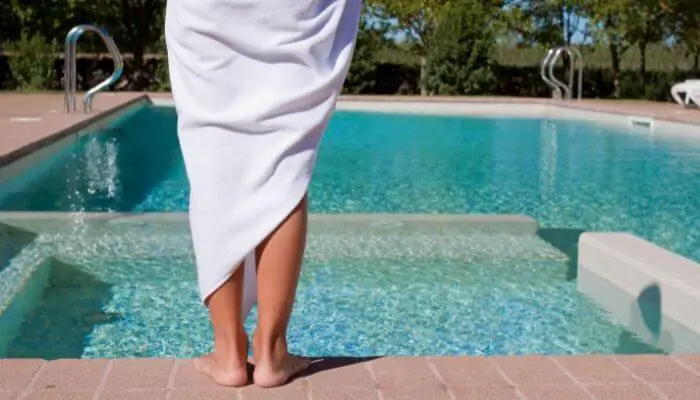Summer is the perfect time to put on your swim attire and show off some skin. Yet, it’s definitely not the right time for swimming with fresh ink.
If you have a new tattoo, this means your skin is still sore and sensitive, like an open wound.
So, ideally, the only time it should get wet is when you’re cleaning the area around it or taking a shower.
In fact, experts advise you to avoid doing any kind of water activity until your skin heals.

Though, there might come a time when you absolutely must go swimming during this time.
Maybe you have physical therapy, rehab, or you have to deal with an emergency.
Whatever the reason, you’ll be happy to know that there are a few temporary fixes to this problem.
One example is wrapping the tattoo in plastic wrap, another is covering it with a medical sealant.
Keep reading for more ideas on how to waterproof a tattoo for swimming.
1. Wrap The Tattoo In Plastic Wrap
It may sound funny, but tattoo artists actually recommend covering your ink with plastic wrap, like Saran Wrap.

It works great on the first couple of nights sleeping with your fresh ink, and it’s also an easy way to keep tattoos nice and dry.
Just remember to apply a thin layer of ointment or mild moisturizer first. Then, place a layer of gauze or a paper towel.
Together, they form an airtight barrier to help limit the amount of moisture that can seep in and affect your skin.
In short, it’s an ideal way to reduce the risk of infections and help boost the healing process.
That said, the less you use plastic wrap to cover your tattoo, the better.
Remember that for your skin to return to normal, it needs to breathe, which it can’t do if it’s covered up.
2. Seal The Plastic With A Medical Sealant
A medical sealant is a type of surgical glue used by physicians to repair wounds. This makes them a no-hassle solution when waterproofing new tattoos.
One brand many tattoo artists swear by is SkinLock.

It’s easy to apply, and the best part is that it works in 30 seconds or less, which is pretty quick.
Apply 3–4 coats each day for even coverage.
Then, after about 7–10 days, the sealant will fall off on its own.
That should give the skin time to mend, while maintaining the integrity of the tattoo.
3. Safer Alternatives to Using Vaseline
Vaseline, or petroleum jelly, isn’t something you should use as part of your tattoo aftercare. For one, it blocks airflow and locks in moisture.
In addition, it traps dirt and bacteria, which can lead to skin irritations.

Case in point, it can do more harm than good on fresh tattoos.
The good news is that there are a handful of alternatives to using Vaseline to waterproof your skin art, like the ones listed below:
- Coconut oil
- Cocoa butter
- Shea butter
- Skin cream specifically made for tattoo aftercare
- Alcohol-free, fragrance-free skin moisturizer, like Eucerin or Lubriderm
The best way to apply any of these substitutes is after gently washing and drying your skin.
Then, apply a thin layer over the tattoo about 3–4 times each day.
4. Be Careful With Your Tattoo Immediately After Your Swim
Imagine that you couldn’t resist the urge and just had to go swimming. What do you do afterward to help protect your ink and keep your skin healthy and free from inflammations?
For argument’s sake, let’s just say you covered your tattoo with a waterproof dressing or wrap.

One of our favorites is the adhesive medical waterproof tattoo bandage called Saniderm.
It’s flexible, breathable, and, best of all, available in different-sized rolls and sheets for added convenience.
Remember that the longer the tattoo is covered, the longer it’ll take to get better.
So, make sure you remove the dressing immediately after coming out of the water.
Rinse the dressing with lukewarm water and pat dry.
Then, gently remove it then clean your skin with mild soap or an antibacterial wash and water.
Finally, give your skin a final pat down with a soft, clean towel.
As a final precaution, apply healing ointment or skin cream to help reduce skin inflammations.
They can also help preserve your tattoo’s design and color.
How Long After Getting A New Tattoo Should You Wait To Go Swimming
While it’s different for everybody, the consensus is that tattoos take 2 to 4 weeks to heal.
For some, however, it can take up to a whole three months for the skin to completely recover.
It mainly depends on the size and type of the tattoo, your skin type, and your aftercare routine.
So, it’s important you avoid exposing your fresh ink to chlorine or saltwater during this time.
The Dangers Of Swimming With A New Tattoo
Here are some risks you can face when swimming with a new tattoo.
Swimming In The Pool
Swimming pools contain chlorine to kill off algae and bacterial growths.
Yet, the problem is that chlorine is a chemical that can irritate the skin around your tattoo.
This can lead to rashes, itchiness, and redness.
You should also keep in mind that chlorine is used to remove stains.
So, it’s likely that the chlorine might ruin the tattoo and make it look drab or washed-out.
Swimming In The Sea
You’re probably thinking that since pools contain harmful chemicals, taking a dip in the ocean is better for your skin.
After all, it’s all-natural, right? Wrong!
Water from the sea or ocean isn’t sterile.
It contains microbes that can aggravate your skin, causing it to become red and inflamed.
Moreover, the salt in the water is an irritant in itself and can make your skin feel sore.
Enjoy Swimming With Your New Tattoo
Experts advise against swimming with fresh ink.
However, it is possible to fully waterproof a tattoo for swimming if you need to:
- Wrap the tattoo in plastic wrap or..
- Use a medical sealant or..
- If you have no other options available coconut oil, shea butter or cocoa butter can work too.
Then remember to wash and clean your tattoo carefully after your swim.
Following these steps will minimize the risk of infection and skin inflammations and lower the chances of ruining the artwork.
